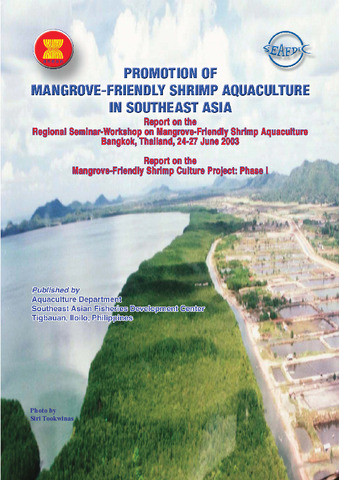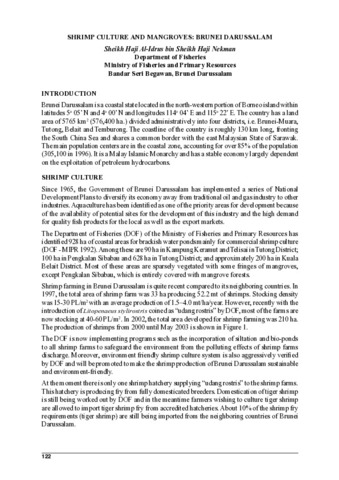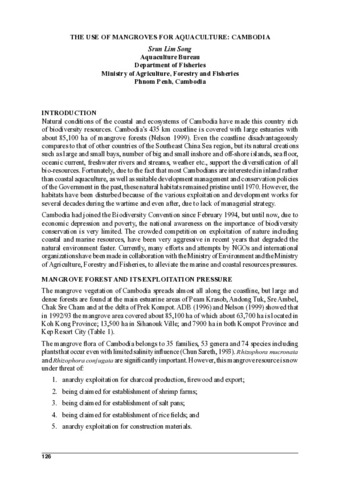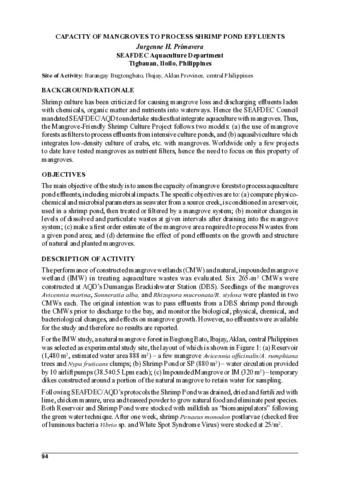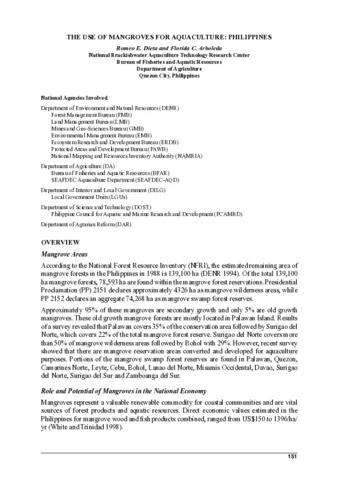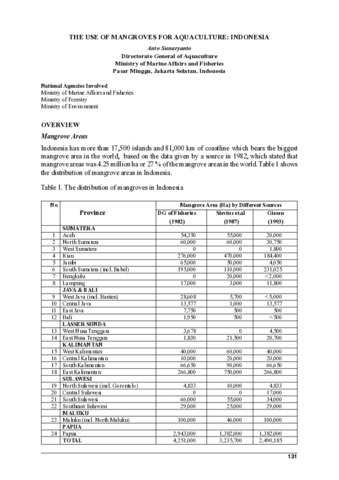Pencarian
Now showing items 1-10 of 25
Promotion of mangrove-friendly shrimp aquaculture in Southeast Asia
(Aquaculture Department, Southeast Asian Fisheries Development Center, 2004)
This publication comprises two major parts : Report on the Regional Seminar-Workshop on Mangrove-Friendly Shrimp Aquaculture, Bangkok, Thailand, 24-27 June 2003 ; Report on the Mangrove Friendly Shrimp Culture Project: ...
Use of mangroves for aquaculture: Myanmar.
(Aquaculture Department, Southeast Asian Fisheries Development Center, 2004)
Aquaculture has only started to develop rapidly in the past few decades, due to better knowledge of culture species, improved methodologies and techniques in breeding, nutrition and increasing demand for food fish of ...
Shrimp culture and mangroves: Brunei Darussalam.
(Aquaculture Department, Southeast Asian Fisheries Development Center, 2004)
Brunei Darussalam is a coastal state located in the north-western portion of Borneo island within latitudes 5o 05’ N and 4o 00’ N and longitudes 114o 04’ E and 115o 22’ E. The country has a land area of 5765 km2 (576,400 ...
The use of mangroves for aquaculture: Cambodia.
(Aquaculture Department, Southeast Asian Fisheries Development Center, 2004)
Natural conditions of the coastal and ecosystems of Cambodia have made this country rich of biodiversity resources. Cambodia’s 435 km coastline is covered with large estuaries with about 85,100 ha of mangrove forests (Nelson ...
Capacity of mangroves to process shrimp pond effluents.
(Aquaculture Department, Southeast Asian Fisheries Development Center, 2004)
Shrimp culture has been criticized for causing mangrove loss and discharging effluents laden with chemicals, organic matter and nutrients into waterways. Hence the SEAFDEC Council mandated SEAFDEC/AQD to undertake studies ...
Report of the Regional Technical Consultation for the Development of Code of Practice for Responsible Aquaculture in Mangrove Ecosystems.
(Aquaculture Department, Southeast Asian Fisheries Development Center, 2005)
The use of mangroves for aquaculture: Philippines
(Aquaculture Department, Southeast Asian Fisheries Development Center, 2004)
According to the National Forest Resource Inventory (NFRI), the estimated remaining area of mangrove forests in the Philippines in 1988 is 139,100 ha (DENR 1994). Of the total 139,100 ha mangrove forests, 78,593 ha are ...
The use of mangroves for aquaculture: Indonesia.
(Aquaculture Department, Southeast Asian Fisheries Development Center, 2004)
Indonesia has more than 17,500 islands and 81,000 km of coastline which bears the biggest mangrove area in the world, based on the data given by a source in 1982, which stated that mangrove areas was 4.25 million ha or 27 ...
The use of mangroves in Malaysia
(Aquaculture Department, Southeast Asian Fisheries Development Center, 2004)
Mitigation plan on the use of mangroves for aquaculture: Thailand.
(Aquaculture Department, Southeast Asian Fisheries Development Center, 2004)
Mangrove forest is one of the important coastal natural resources of Thailand, however, mangrove forests have deteriorated very rapidly at a rate of more than 50% of the mangrove loss during 1961–1996. The utilization and ...

